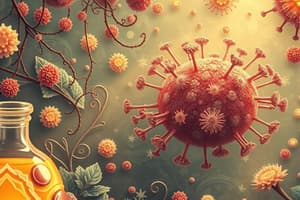Podcast
Questions and Answers
What is the primary difference between disinfectants and antiseptics?
What is the primary difference between disinfectants and antiseptics?
Disinfectants kill vegetative cells on surfaces, while antiseptics kill vegetative cells on living tissue.
Why are narrow spectrum drugs considered more desirable than broad spectrum drugs?
Why are narrow spectrum drugs considered more desirable than broad spectrum drugs?
Narrow spectrum drugs target specific pathogens and cause less harm to normal microbiota.
Define intrinsic resistance in the context of antibiotics.
Define intrinsic resistance in the context of antibiotics.
Intrinsic resistance refers to the natural immunity of certain bacteria against specific antibiotics.
What role do second metabolites play in microbial interactions?
What role do second metabolites play in microbial interactions?
What is the significance of zones of inhibition observed during the Agar Disk Diffusion Assay?
What is the significance of zones of inhibition observed during the Agar Disk Diffusion Assay?
How does acquired resistance occur in bacteria?
How does acquired resistance occur in bacteria?
Describe the function of the Kirby-Bauer Method in determining antibiotic susceptibility.
Describe the function of the Kirby-Bauer Method in determining antibiotic susceptibility.
List one reason why a disinfectant may not work effectively in real-world settings compared to an agar plate.
List one reason why a disinfectant may not work effectively in real-world settings compared to an agar plate.
What key information does the chart value provide in interpreting antibiotic susceptibility?
What key information does the chart value provide in interpreting antibiotic susceptibility?
Explain why not all antibiotics work equally against all bacteria.
Explain why not all antibiotics work equally against all bacteria.
What factors should be considered when selecting a disinfectant for effective use?
What factors should be considered when selecting a disinfectant for effective use?
Why might a healthcare provider opt for a broad-spectrum antibiotic instead of a narrow-spectrum one?
Why might a healthcare provider opt for a broad-spectrum antibiotic instead of a narrow-spectrum one?
What constitutes the misuse of antibiotics?
What constitutes the misuse of antibiotics?
How does overuse of antibiotics contribute to antibiotic resistance?
How does overuse of antibiotics contribute to antibiotic resistance?
What characteristics define coliform bacteria as indicator species?
What characteristics define coliform bacteria as indicator species?
What is the primary purpose of pasteurization in food safety?
What is the primary purpose of pasteurization in food safety?
What is the primary foodborne pathogen linked to contaminated poultry?
What is the primary foodborne pathogen linked to contaminated poultry?
Describe the method of serial dilution and its application in counting bacteria.
Describe the method of serial dilution and its application in counting bacteria.
How is the final number of bacteria per ml calculated using colony forming units (CFUs)?
How is the final number of bacteria per ml calculated using colony forming units (CFUs)?
What is the significance of storing milk at 4 degrees Celsius?
What is the significance of storing milk at 4 degrees Celsius?
Flashcards
Disinfectant
Disinfectant
A substance used to kill germs on surfaces.
Antiseptic
Antiseptic
A substance used to kill germs on living tissues.
Synthetic antibiotic
Synthetic antibiotic
An antibiotic created in a lab.
Semi-synthetic antibiotic
Semi-synthetic antibiotic
Signup and view all the flashcards
Narrow-spectrum drug
Narrow-spectrum drug
Signup and view all the flashcards
Broad-spectrum drug
Broad-spectrum drug
Signup and view all the flashcards
Intrinsic resistance
Intrinsic resistance
Signup and view all the flashcards
Acquired resistance
Acquired resistance
Signup and view all the flashcards
Filter Paper Disk Method
Filter Paper Disk Method
Signup and view all the flashcards
Kirby-Bauer Method
Kirby-Bauer Method
Signup and view all the flashcards
Antibiotic Misuse
Antibiotic Misuse
Signup and view all the flashcards
Antibiotic Overuse
Antibiotic Overuse
Signup and view all the flashcards
Antibiotic Resistance
Antibiotic Resistance
Signup and view all the flashcards
Coliform Bacteria
Coliform Bacteria
Signup and view all the flashcards
Indicator Species (e.g., E. coli)
Indicator Species (e.g., E. coli)
Signup and view all the flashcards
Pasteurization
Pasteurization
Signup and view all the flashcards
UHT Pasteurization
UHT Pasteurization
Signup and view all the flashcards
Standard Plate Count
Standard Plate Count
Signup and view all the flashcards
Serial Dilution
Serial Dilution
Signup and view all the flashcards
CFU (Colony Forming Unit)
CFU (Colony Forming Unit)
Signup and view all the flashcards
Study Notes
Disinfectants and Antiseptics
- Disinfectants kill vegetative cells on surfaces.
- Antiseptics kill vegetative cells on living tissue.
- Synthetic antibiotics are lab-made.
- Semi-synthetic antibiotics are modified naturally-produced antibiotics.
- Narrow-spectrum drugs target pathogens, minimizing harm to normal microbiota.
- Broad-spectrum drugs are used when the cause of infection is unknown, or other antibiotics are ineffective.
- Intrinsic resistance is natural immunity to antibiotics.
- Acquired resistance arises from antibiotic misuse or overuse.
- Susceptibility is the state of being influenced by something.
- Streptomyces are gram-positive, saprophytic (feeding on decaying matter), spore-forming bacteria found in soil.
- They produce secondary metabolites (organic compounds not essential for growth but beneficial to interacting organisms).
Antibiotic Testing Methods
- Filter Paper Disk Method/ Agar Disk Diffusion Assay: Observe zones of inhibition (areas around disks where no bacterial growth is detected) to assess the effectiveness of disinfectant or antiseptic.
- Zephiron Chloride and Vesphene effectively disinfected E. coli and S. aureus.
- Kirby-Bauer Method: Determines antibiotic susceptibility.
- Mueller-Hinton Agar: Used in larger petri dishes to test multiple antibiotics simultaneously.
- Findings:
- Some bacteria show intrinsic resistance to certain antibiotics (indicated by small colonies within zones of inhibition).
- Antibiotics' effectiveness varies among bacterial types.
- The interpretation of antibiotic susceptibility values is crucial for diagnosis and treatment.
Factors Affecting Disinfectant Choices and Antibiotic Use
- Laboratory effectiveness doesn't always translate to real-world situations due to environmental factors.
- When choosing disinfectants, consider cost, water solubility, exposure time, shelf life, and toxicity.
- Health care providers might use broad-spectrum antibiotics when infection cause is unknown.
- Antibiotic misuse involves using them for viral infections; overuse is incorrect dosage use.
- Misuse and overuse contribute to acquired resistance and allows intrinsic resistant strains to become more common.
Coliform Bacteria & Food Safety
- Coliform bacteria are gram-negative, non-spore-forming bacteria that ferment lactose, producing acid and gas.
- Fecal coliforms are abundant in human/animal intestines.
- Indicator species (e.g., E. coli) aren't commonly found in the natural environment without fecal contamination.
Food Preservation Methods
- Pasteurization: Reduces microbial load in foods (milk, fruit juices).
- Ultra-High Temperature (UHT) Pasteurization: Sterilizes foods under aseptic conditions.
- Store milk at 4°C to prevent bacterial growth.
Foodborne Pathogens
- Salmonella is a common foodborne pathogen linked to contaminated poultry.
- Fruits and vegetables can be contaminated by soil or water during growth.
- Processing, storage, and preparation can also cause contamination.
Methods for Determining Bacterial Load
- Standard Plate Count: Quantifies bacteria.
- Serial dilutions of food are plated on growth media, and colony-forming units (CFU) are counted.
- CFUs may represent more than one bacterium colony.
- Serial Dilution: Creates very dilute solutions.
- Dilute solutions, then dilute the dilution etc...
- Results from multiple dilutions are averaged to determine bacteria per ml.
Studying That Suits You
Use AI to generate personalized quizzes and flashcards to suit your learning preferences.




